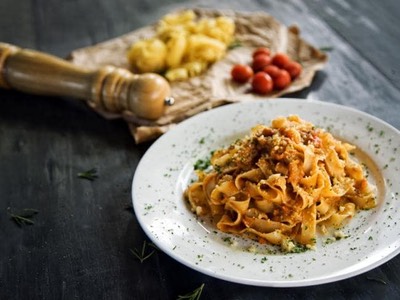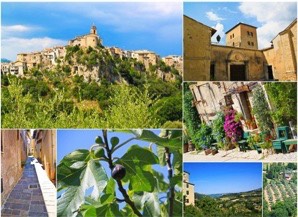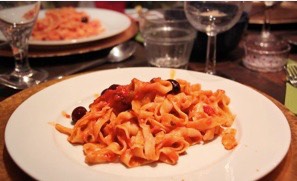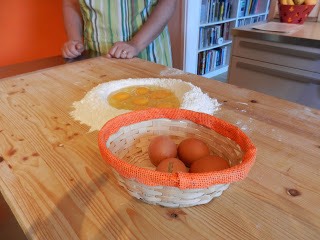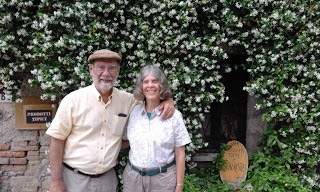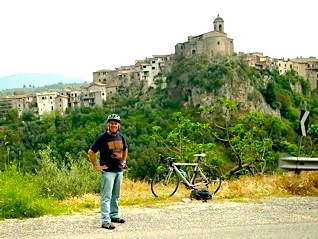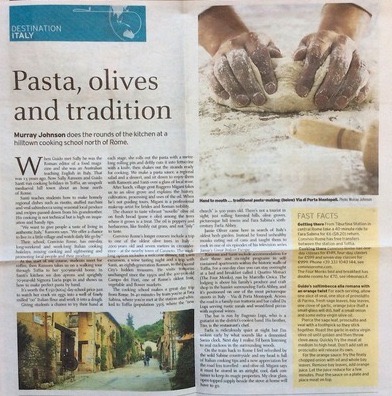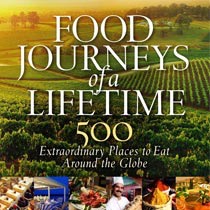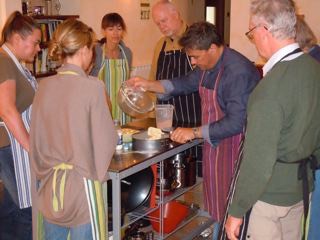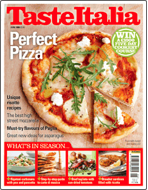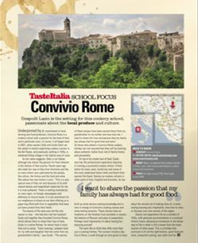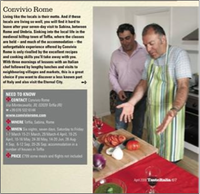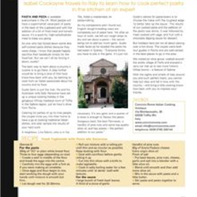"THE BEST OF ITALY: AMALFI COAST, CAPRI AND ROME”
Escape travel magazine - by Jane Armitstead, Travel Writer.
"Among Italy’s most humble charms is how it’s ancient world bares such influence on the current lifestyle. This isn’t just seen through legends and landscapes but through the country’s next greatest obsession, food.
Even though the food culture is ever-changing, centuries-old recipes are still being used. There’s no better way to get to the heart of this tradition than to make it yourself.
An hour north by train from Rome is the little-known Sabine Hills, a place blissfully lost in time in the Italian countryside, dotted with medieval villages.
I’m in the family kitchen of husband and wife team, Sally and Guido, an Australian expat from Sydney and an eighth-generation Roman, who call this region home.
They’ve been letting people in on their secret hideout by hosting cooking classes for the past 16 years. Out their kitchen window, I lose myself in the rolling mountains and the fields of endless olive groves.....”
Martha's Visit to the Sabine Hills, just north of Rome (Marta’s Italy)
It was a real pleasure introducing Martha and James, to some of the hidden villages of the Sabine Hills. We have been in contact with Martha, an Italian travel expert, for many years, but this was the first time we had a chance to show our friends around.
Martha has travelled to all of Italy’s 20 regions and is passionate about sharing her vast travel experiences with others. Find out what she wrote about her day with us in her newsletter:
Convivio Rome’s Spaghetti alla Carbonara recipe shared on American Fox2TV
Spaghetti alla Carbonara is a classic Roman recipe that is fast and relatively simple. In my Italian cooking classes over the years, I have found many cooking guests are pleasantly surprised at how easy this delicious recipe is to replicate at home.
Here are some of my tips, to ensure the success of this traditional dish, as revealed by Carol, one of our valued ex-cooking guests on American Fox2TV.
Thank you Carol for spreading the word.
Rick’s Rome - Rome blog Site
Food Tours in Rome by Rick Zullo
Good food starts with high quality ingredients. And perhaps no ingredient is more integral to Italian cooking than olive oil. Fortunately, the area surround Rome produces some of the best olive oil in the world. It may not be as well-known as some other olive producing regions, but the savvy connoisseurs are well aware of its considerable merits.
I met Guido, a native Roman, and his Australian wife Sally in the Sabine Hills to learn a bit about cultivating olive trees and olive oil production. Growing up in Rome, Guido and his brother often accompanied their father into the countryside on the weekends to buy top quality products and seasonal ingredients directly from local producers. Wine, fruit, vegetables, cheese, and of course, olive oil.
A few years ago, he and Sally decided to give up big city life for the peaceful charm in the village of Toffia, about 45-50 minutes outside of Rome. Now instead of fighting traffic and breathing diesel exhaust, they arrange cooking holidays, along with wine and olive oil tours for their company Convivio in the lush, green countryside. I joined them for half a day to improve my understanding of what goes into making high-quality oil, from tree to table.
Our first stop was near the village of Canneto to behold, “Olivone,” Europe’s largest olive tree, more than 7 meters (22 feet) in circumference around the base (and one of the oldest, estimated at more than 2,000 years). And yes, it still produces fruit.
Some interesting facts about olive trees and olive oil:The first known cultivation of olive trees occurred on the island of Crete around 3,500 B.C. Trees grow best on the side of a steep hill, with good sun exposure, in dry but breezy conditions.
The trees benefit from active cultivation, keeping the branches trimmed so that air can reach the center of the tree.
Trees reach full maturity at around 20 years old, and produce their best olives between 35 and 150 years old. Often, at around 200 years, a separate off-shoot will spontaneously form, giving the tree new life. Reincarnation, if you will.
It takes about 5 kilos of olives to produce one liter of oil. Our friend “Olivone” yielded 120 kilos a year when he was at his peak. Now he makes about 70 kilos a year.
An Olive Farm
We got back in the car and followed rough country roads through the hills. The path grew progressively narrower and steeper before eventually arriving at an olive tree farm called, “Il Cervo Rampante.” Here we strolled among the thick groves, which contained some very young trees at just 5 months old, and some very old trees at more than 500 years. There were several different varieties present, and we’d learn more about their unique flavor qualities during the tasting session at the end of the tour.
When tasting good oil, it’s important to identify a bitter, peppery after taste towards the back of the palate. These are the high quality oils that you’d want to use to dress a salad or grilled vegetables, or drizzle on your fresh fish. Don’t ruin a dish that you’ve carefully prepared by finishing it with industrially produced oil. Yes, the good stuff costs a little more, but it’s well worth it.
If you’re visiting Rome and want to learn more about olive oil, its characteristics and proper uses in the kitchen, then I suggest you contact Guido and Sally through their website. Besides the tours through the country, the also offer one-day cooking classes, as well as full culinary holidays in the hills just outside of Rome.
Romeing.it - Rome Magazine
Olive Oil Tour with Convivio Rome by Lauren Mouat
When I think of Italy, I think of its flavors: creamy gelato, yummy wine, handmade pasta, crunchy bread and of course, its olive oil. Despite living here for years I still felt like I didn’t understand much about this staple of Italian cuisine so on a Friday morning I joined Convivio Rome’s olive oil tour and got the chance to experience the stunning Sabine Hills, a more rugged kind of Tuscany right on Rome’s doorstep, an easy train ride from the city, and famous for its olio d’oliva.
The word convivium is from Latin and means feasting or living together and that is just the philosophy of the couple who run Convivio Rome. Guido is an 8th generation Italian and Sally is a transplant from Australia who came to Rome for a month and ended up staying! Over the course of four hours, Guido and Sally shared with us their passion for good food, the Italian countryside, and a way of life that is based on sharing and community, just like the olive oil tradition.
Picking olives was a time when families and communities came together, sharing in the work and a large communal lunch in the shade of the olive trees. In fact there is little evidence on how to cultivate olives in Sabina because it’s all simply been passed down by word of mouth. In my opinion, this is still the best way to learn about olive oil.
I learned how olive oil is made and what is characteristic of a good olive oil. I also got to visit Europe’s oldest olive tree, explore an organic oliveto (olive farm), talk to the farmers, and taste some fruity, peppery olive oil drizzled over simple white bread. Of course I brought some home with me and every time I uncork the bottle and get a whiff of olives I remember walking through sun soaked olive groves and the delightful company and extensive knowledge of our guides with Convivio Rome.
The Ultimate Gastronomy Getaway
by Melissa Hartson
Italy is a wonderful country steeped in history, tradition, and of course some of the best food on Earth. If you have a passion for Italian cooking and are currently looking for a unique holiday experience, Convivio Rome can help. They combine fantastic food with an unforgettable holiday to Italy, and with accommodation located in the beautifully preserved medieval hilltop village of Toffia (near Rome) this will be one holiday you won’t forget. Convivio Rome offer holidays to suit every need from one day breaks to five night long holidays so be sure to check their programmes page for more information.
A Passion for Food
Guido and Sally have been providing cookery courses which has allowed their passion for gourmet Italian food and cooking to grow greatly, and inspire countless others to create their very own gourmet food. Guido has promoted Italian cuisine across the globe, drawing from his family’s recipes, and their passion for quality Italian food. Guido is an 8th generation Roman himself and spent most of his live in Italy, this helps create an authentic cooking experience for all his guests. Guido is in charge of the cooking classes, olive oil tours, and wine-tasting sessions. He is fully bilingual, enabling him to accommodate both English and Italian speaking tourists.
Mediterranean Medley
It isn’t just Italy that has a strong culinary tradition as the whole of the Mediterranean is full of unique and wonderful dishes to suit every taste. If you are considering a tour of the Mediterranean there is no better way to experience the laid back Mediterranean lifestyle, and unique culture than a cruise. With many Mediterranean cruises starting or ending in Italy it could be an ideal adventure to add to your time with Convivio Rome. Why not take a cruise around Italy and experience the rich diversity of local cuisine and tradition from Venice to Naples. For more ideas on how to create your perfect culinary adventure across Italy be sure to check out the official Italian travel site for itineraries and inspiration.
Into the Country
The Roman countryside is a breath taking combination of history and nature with unique and beautiful structures from its long history. Toffia is at the heart of this, located in the Sabina region between Rome and Umbria expect to see stunning views across the medieval city and dramatic countryside during your culinary holiday with Convivio Rome. The Sabina region has a strong culinary tradition, and with many food festivals over the year you will be able to experience the fresh local cuisine. With food festivals running the entire year you can always get out and try some of the unique local food.
Accommodation
Convivio Rome's accommodation is located in the medieval village of Toffia, in a small number of restored historic homes providing a unique and unforgettable experience. All the homes are self-contained, clean, and designed in a beautifully rustic nature.
Why Wait?
With courses running all year round Convivio Rome Italian Cooking Holidays aim to suit your hectic lifestyle providing slots at times suitable to you across the year. Each cooking class is tailored to the current season helping create a rich diversity in the food prepared over the year, and giving you more reason to see them again. Be sure to check their Date-Prices page for more information on booking your perfect culinary get away.
The Picky Eater Healthy Eating Blog
by Anjali
As many of you know, the husband and I recently returned from an amazing trip to Italy. One of the highlights of our trip was a day-long cooking class we took through Convivio Rome - run by a husband and wife team, Sally and Guido, in a tiny medieval town named Toffia.
We literally spent the entire day with them – from 10am-5:30pm and enjoyed every minute of it! And as a result, I came away with delicious, authentic, healthy Italian recipes. We took about a 45 minute train ride from Rome to a small town near Toffia, where Sally was there to greet us with a warm smile and enthusiastic welcome. On the drive to her and Guido’s house, we learned a bit about the history of these medieval towns and what our day would be like. Toffia is a quaint, rustic, cozy little town that makes you feel like you are far away from the bustling city of Rome. It has gorgeous views with groves of fresh olive trees everywhere – and we couldn’t resist taking a few pictures. We arrived in Toffia and took a little walking tour through the town, picked fresh herbs from a nearby garden to use in our cooking (I nearly died when I smelled the fresh lemon verbena), and headed to meet Guido – our chef instructor for the day. Our class started with making the fresh pasta from scratch – using nothing but our hands and an enormous wooden cutting board. And then, we started on the next two dishes on our menu – the stuffed zucchini blossoms and ricotta tart! Needless to say, we had worked up quite an appetite when we got around to eating! The pasta was perfectly cooked, the sauce was full of flavor, and I couldn’t believe how simple this recipe was with just a few ingredients. You could really tell how fresh and high-quality the ingredients were, and it was undeniable that homemade pasta was in a different echelon of food. It was truly slow food, hand-made, locally sourced, and felt healthy and hearty.
Tip for cooking pasta: Italians always cook pasta super “al dente.” Al dente pasta (which in Italy, is more than what you’re typically used to thinking of as “al dente”) is actually much healthier than cooking pasta for the entire time most package directions call for. Al dente pasta is lower glycemic – which means that it doesn’t give you that blood sugar spike and crash that typical carbs do. It also takes much longer to chew and digest, which means you’re likely to eat much less of it in the same period of time. After eating al dente pasta you don’t feel that same heavy/bloatedness that you could get from eating a whole plate of regularly cooked pasta. I actually like the taste and texture of al dente pasta better too. So next time you make pasta – try cooking it just a little bit less than normal – enough so that it has a noticeable “bite.” That way you can have your pasta and eat it too! Needless to say, we had worked up quite an appetite when we got around to eating!
The pasta was perfectly cooked, the sauce was full of flavor, and I couldn’t believe how simple this recipe was with just a few ingredients. You could really tell how fresh and high-quality the ingredients were, and it was undeniable that homemade pasta was in a different echelon of food. It was truly slow food, hand-made, locally sourced, and felt healthy and hearty.
Shertology -
Our Idyllic Escape from Tourists in Toffia, Italy
by Sherry Toly
While planning our activities while in Rome, April and I discussed taking some cooking lessons so we could perfect our Italian cooking skills. April researched the many options available and instead of staying right in Rome, we found an option about 45 minutes outside of Rome in Toffia with Convivio Rome Cooking Classes. Our daylong adventure in Toffia is probably one of my favorite things we did/experience on our entire trip. To quote Liz Lemon, "I want to go there."
Toffia is a small hilltop village with a current population of about 350 people, although their population swells closer to 900 people during the warmer months as many Romans like to keep summer homes there. Located in the ancient Sabina region, the area is an agricultural-rich area with primarily olive oil and wine production. April and I were joined by two more cooking "guests" who were a mother and daughter from Canada, so it was a nice small group. Convivio Rome is ran by a sweet couple, Guido (8th generation Roman) and Sally (Australian who fell in love with Guido while visiting Rome) who live in Toffia. We were all picked up at the Fara Sabina train station, about 45 minutes outside of Rome, and driven by a cute Italian boy to Toffia, about 20 minutes away. Sally met us at the entrance to the city and as we walked towards their home, gave us a bit of a tour along the way.During our walk into the center of the village, one of the local "wine growers" passed us several times with his bounty of just-picked grapes.
All of the wine produced by the villagers is for "local-use" only, meaning that all of the residents basically bring their bottles and containers to be filled up after the harvest. They do a similar thing with the olive oil production with residents basically acquiring their year-long needs shortly after the harvest and production. I think that they actually pay for the wine and olive oil, but the amount is quite minimal.
Toffia features a community garden and we stopped there to pick some fresh herbs to use during our cooking lesson.We arrive at Sally and Guido's home and after a brief introduction to Guido, our lesson begins. I think one of the reasons why I enjoyed our day so much here is that Sally and Guido were instantly like old friends. And the food we prepared was amazing!
I loved that we were kind of thrown back into an era where you actually knew all of the people that produced your food; they personally know (and are friends with) the butcher, the guy who grows the vegetables, the cheesemaker, the olive maker and the wine maker. I suspect they also acquired the flour from someone they know who mills it.
First up, we learn to make tagliatelle pasta (your basic egg noodle). April and I have made pasta many times, but this recipe varies slightly in that the ratio of eggs was a bit higher, and instead of using just all-purpose flour, it was a mixture of 50% all-purpose flour (European 00 flour) and 50% semolina flour.
This was the first time we had learned to make pasta entirely by hand, meaning that we didn't use a sheet roller to create the thin pasta sheets. I'm pretty sure my french rolling pin isn't quite long enough for this method, so I'm going to need some supplies when I get home!
After the pasta was completed, it was time to start the Ragu (a basic meat sauce). This is a basic staple sauce in most Italian kitchens and Guido told us that on Sundays, you can smell various wafts of Ragu from most kitchens in the village.
The sauce begins with a basic mire poix of celery, onions, carrots, then flavored with pieces of pork cheek (kind of like pancetta, but the cut of pork comes from the pig cheek) and fresh bay leaf. There was also a generous amount of olive oil. After this mixture was cooked down for a few minutes, we added some ground beef and wine.
Finally, the Italian version of tomato sauce, as well as a can of "San Marzano" tomatoes were added to the mixture and set aside to simmer while we prepared the rest of today's dishes.
Next up was the dessert, Ricotta cake. I loved how everything we did was made entirely by hand; no blenders, food processors, or mixers. Even the pastry dough for the cake was done on the board by hand. I though it was an ingenious idea to keep the parchment on the bottom of the pastry to line the dish with. Spread on the bottom was a locally-made (naturally!) cherry preserve that was more similar to a currant (the cherries are tart) then our sweet bing cherries. The ricotta filling was simply sheep's milk ricotta (apparently sheep's milk is sweeter than cow's), sugar, eggs, chopped chocolate (which was also made locally) and some fresh lemon zest. And voila! In a matter of a few minutes, it's ready to bake and you have a very simple, but delicious dessert.
Finally, it's time to create the meat course: Veal Saltimbocca. It's amazing how something so simple to make can be so delicious. I definitely think it's the olive oil!
Paper-thin slices of veal are layered with a slice of prosciutto and skewered together with a fresh sage leaf. That's it! No salt, no pepper. It's then quickly sauteed (fairly high heat) with some olive oil (but of course!). Paired with a simple arugula salad and an orange reduction sauce (which we also made), it was very delicious. Isn't your stomach rumbling just reading about these dishes? Guido told us a funny story about how he tried out his idea of the "orange sauce" to pair with the Saltimbocca on his Roman friends. Their basic response when tasting his version was "it's not like Nona makes." Apparently you can't teach a dog new tricks and they only want to eat something that's exactly what they're used to, and in this case, whatever their beloved grandmother's made. Hopefully my grandchildren will feel that way about my cooking! It was now time to eat, so we all retired to their "taverna" which is kind of "cave-like" and very cool. What a great place to entertain! Sally told us that they're often asked by fellow villagers if they can host a party in their taverna! It's the perfect spot for a party.
From the flat area where the dining table is located, looking across the room is the entrance to their cellar, also a nice place to sit and enjoy a glass of wine. Our meal, complete with a generous amount of local wine was one of the highlights of my trip to Italy. The day was perfect! It was warm and sunny, the class was fun and engaging and I am completely in love with Toffia. Remember the movie "Under the Tuscan sun" where Diane Lane's character is on vacation in Tuscany and she falls in love with the village and buys a villa there? I can see that happening! Seriously, this place is fantastic! But obviously, not very realistic for me, but one can dream! It's now getting to be late afternoon and sadly it's time for us to go. Sally and our cute Italian driver accompany us to another nearby village of Farfa for a quick tour before we drive back to the train station. Along the way, we had some amazing views of Toffia.
The Farfa Abbey is one of the most famous abbeys in Europe. Farfa Abbey played an important role in the history of the Sabina area, having controlled, during it's "golden age", nearly all the nearby towns and villages. The monks of Farfa owned 683 churches or convents; two towns, Civitavecchia and Alatri; 132 castles; 16 strongholds; 7 seaports; 8 salt mines; 14 villages; 82 mills; and 315 hamlets. They even had their own army and navy. It's hard to imagine this fairly small abbey run by monks to have risen to that level of power.
As one of the most powerful Benedictine monasteries in Europe, it played a major role in the power struggles between the Papacy and the Holy Roman Empire, opposing the power of the Papacy for centuries. With the crisis in the Benedictine order and the struggle for the Papacy in the twelfth century, the Abbey began to decline and eventually fell under the control of the Papal States. From here on it's history follows that of the Vatican and the struggles between powerful Roman families for it's control. In 1477 AD the Orsini family asserted it's growing power in the Sabina by expelling all the monks of Farfa and replacing them with Teutonic monks. In the following centuries the Abbey passed under the control of various Roman nobles such as the Barberini and the Farnese but it never really reacquired the importance and independence it once had. Finally, in 1841 AD its powers were definitively transferred to the diocese of the Sabina. While we were visiting the church, a wedding was start about ready to start. We've actually seen quite a few brides during our travels in Italy.
It was an idyllic day. In addition to their one-day classes, Convivio offers 3 and 5-day courses, combined with accommodations in Toffia, either in a shared environment (room of local villager) or sometimes they rent out entire dwellings for the class participants. I'm pretty sure one of these options (3 or 5 days) will be worked into the planning process for a future trip to Italy.
Sydney Morning Herald & The Age (leading daily newspapers in Australia)
feature article (travel section):
"Pasta, olives and tradition"
by Murray Johnson (extract)
Murray Johnson does the rounds of the kitchen at a hilltown cooking school north of Rome.
When Guido met Sally he was the Roman editor of a food magazine and she was an Australian teaching English in Italy. Now Sally Ransom and Guido Santi run cooking holidays in Toffia, an unspoilt mediaeval hill town about an hour north of Rome.
Santi teaches students how to make homely regional dishes such as risotto, stuffed zucchini and veal saltimbocca using seasonal local produce and recipes passed down from his grandmother. His cooking is not technical but is high on inspiration and handy tips.
''We want to give people a taste of living in authentic Italy,'' Ransom says. ''We offer a chance to live in a little village and watch daily life go by.''
Their school, Convivio Rome, has one-day, long-weekend and week-long Italian cooking holidays, mixing cooking and sightseeing and promoting local people and their produce.
At the start of my course, students meet for coffee, then Ransom takes us on a walking tour through Toffia to her 500-year-old home. In Santi's kitchen we don aprons and sprightly 70-year-old Signora Lucia pops in and shows us how to make perfect pasta by hand.
Giving students a chance to try their hand at each stage, she rolls out the pasta with a metre-long rolling pin and deftly cuts it into fettuccine with a knife, then shakes out the strands ready for cooking. We make a pasta sauce, a regional salad and a dessert, and sit down to enjoy them with Ransom and Santi over a glass of local wine.
The chance to taste vibrant ''novello'' olive oil on fresh bread (pane e olio) among the trees where it grows is a treat. The oil is peppery and herbaceous, like freshly cut grass, and not ''oily'' to taste.
Convivio Rome's longer courses include a trip to one of the oldest olive trees in Italy - 2000 years old and seven metres in circumference - at the nearby town of Canneto. The week-long option includes a welcome dinner, hill town excursion, a wine tasting night and a trip with Santi, an eighth-generation Roman, to the Eternal City's hidden treasures. He visits trattorias unchanged since the 1950s and the 400-year-old Campo dei Fiori, one of Rome's oldest fruit, vegetable and flower markets.
The cooking school also makes a great day trip from Rome. In 40 minutes by train you're at Fara Sabina, where you're met at the station and whisked to Toffia (population 350), where the ''new church'' is 500 years old. There's not a tourist in sight; just rolling forested hills, olive groves, picturesque hill towns and Fara Sabina's sixth-century Farfa Abbey.
Jamie Oliver came here in search of Italy's oldest herb garden. Instead he found unhealthy monks eating out of cans and taught them to cook in one of six episodes of his television series Jamie's Great Italian Escape.
Ransom and Santi include accommodation for their three- and six-night programs in self-contained apartments within the historic walls of Toffia.....
National Geographic's Book 'Food Journeys of a Lifetime' distributed worldwide
National Geographic published this wonderful hardcover book listing '500 Extraordinary Places to Eat Around the Globe'. It features Convivio Rome's recipes for Roman artichokes 'Carciofi all Romana'
Rudy Maxa, host and executive producer of the public television travel series, 'Rudy Maxa's World'. Conducted live radio interview on radionews1440.com in USA, and wrote article for Delta Airlines' Sky Magazine:
2 Radio interviews between Rudy Maxa and Sally at Convivio Rome on 'kfwb.com' to LA audiences.
Rudy and his family joined Convivio Rome for part of a week long cooking vacation and wrote about his 'hands on' experiences, for Delta Sky Magazine titled "Cooking School in Italy":
(an extract) " ......Today, Convivio Rome hosts intimate groups (or even individual couples) in the oh-so-charming village of Toffia. They have several very nicely renovated homes in the town available for their guests, and each day (they offer one day or three and six-night experiences), “students” join Guido in preparing a several course meal.
The rest of the day is spent prowling the nearby hills, either at leisure or with Guido and Sally tasting local olive oil or a day trip to Rome. That’s my idea of a perfect cooking school.
Together with five other guests, I rolled out pasta made simply of flour and eggs. Guido showed us how to prepare a simple, authentic ragu al Pomodoro......"
International Lifestyle Magazine - distributed world-wide.
Feature article 'Italian Flare'
by Lynn Nicholson (extract)
Here you can stay and learn to cook traditional and authentic foods using only what is in season, an area which is most certainly non negotiable. By sourcing all their ingredients locally they ensure that they are keeping their carbon footprint to a minimum and of course, this is how a village can maintain its authenticity by not having to look for other, more commercial, ways to survive. This is an area which has stood still in time, a true medieval village, Toffia...
TasteItalia, (leading British magazine for Italian food lovers- distributed world-wide).
Feature article 'Italian Cookery School Focus - Convivio Rome'
"Unspoilt Lazio is the setting for this cookery school, passionate about the local produce and culture.
Underpinned by a commitment to local farming and food producers, Convivio Rome is a cookery school with a passion for the food of Italy and in particular Lazio, of course. It all began when owners Sally and Guido Santi eventually settled in Toffia, a medieval hilltop village in the Sabina area of Lazio. As her name suggests, Sally is not Italian, although she shares the passion for food inherent in the natives of that country. Eleven years ago she made her way to Italy from Australia and like so many others was captivated by the people, the culture, the history and the food and wine. She adores her new home in Lazio. “This is a very special area of Italy not only because of its wild natural beauty and magnificent views but for me it is truly authentic. There is nothing commercial, no neon signs, no foreign newspapers and definitely no tourist buses. It is not uncommon for our neighbours to knock on our door offering us a paper bag filled with fruit or vegetables that have just been picked from their fields.”
The beauty of the area was not the only reason to stay – she had also met her husband Guido and together they founded Convivio Rome Italian Cooking holidays, which allows them to share their love of Italy. Guido is a native Roman, for whom food is more than just a career. “Every evening, I prepare food for my wife and daughter that has come from my grandmother’s family,” says Guido. “The secrets of these Italian recipes have been passed down from my grandmother to my mother and now onto me. I want to share this love and passion that my family has always had for good food and wine.” So those who attend a Convivio Rome cookery holiday can rest assured that they will be learning about authentic Italian food, full of family history and personality. On top of an innate love of food, Guido also has the professional experience requisite in running a successful cookery school. A food editor for many years, Guido has met some of the most celebrated Italian chefs and learnt their secrets first-hand. Having run cookery schools in other parts of Italy, England and Australia, he has built up some serious cooking knowledge and is now in charge of Convivio’s Italian cooking classes and wine-tasting sessions. These classes have an emphasis on the freshest food available in season, the balance of flavours and ease of preparation.
Perhaps most importantly it’s about having fun, enjoying yourself. The team like to think they offer more than just a cooking holiday. The courses include a day trip to Rome, a walk through an olive grove to learn about the ancient art of making olive oil, a wine-tasting evening and, importantly, free time to relax, or discover your own secrets of the region. Guests can experience life as a resident of Toffia, with personal accommodation in a restored historic home, allowing an immersion in the Italian way of life in what is still a haven from the mass tourism of other areas. This is a holiday that hits all the right buttons, good food and wine, a beautiful setting, new skills and fun."
TasteItalia - Feature article 'Sun sea and seasoning' - Convivio Rome is listed as one of the 20 best cookery schools in Italy.
"Living like the locals is their motto. And if these locals are living so well, you will find it hard to leave after your seven-day visit to Sabina, between Rome and Umbria. Sinking into the local life in the medieval hilltop town of Toffia, where the classes are held – and much of the accommodation – the unforgettable experience offered by Convivio Rome is only rivalled by the excellent recipes and cooking skills you’ll take away with you. With three mornings of lessons with an Italian chef followed by lengthy lunches and visits to neighbouring villages and markets, this is a great choice if you want to discover a less known part of Italy and also visit the Eternal City."
Cambridgeshire Journal - British monthly lifestyle and social magazine.
"Isabel Cockayne travels to Italy to learn how to cook perfect pasta in the kitchen of an expert."
"The best way to learn about a country’s cuisine is to go there. A step further would be to bring a slice of that food know-how back with you, by learning to cook from an Italian passionate about his country and its food. Guido Santi is just the man. He and his Australian wife Sally Ransom have set up a unique cooking holiday in the gorgeous hill-top medieval town of Toffia in the Sabina region, just an hour’s drive from Rome.....
Guido’s advice for pasta-lovers is to choose the make with the roughest edge ‘to better take up the sauce’. The results of our cooked pasta and the addition of the pesto was divine. It was followed by meat cooked with sage and fruit with a chocolate dipping sauce for dessert. But holidays here are not all about slaving over a hot stove. We visited an olive grove, walked around the pretty village of Farfa and enjoyed a car ride up to see more historic hilltop towns – a feature of Sabina. With the sights and smells of Italy around you and such perfect hosts, you cannot help but relax and fall in love with the country – and bring a little cooking know- how back with you to impress your friends."
The Liberty Times - Taiwan's biggest daily newspaper.
This article was submitted by Cecily, one of our cooking guests, after her week-long cooking holiday with Convivio Rome. This is the e-mail she kindly sent to us:
"I tried to write down my Toffia Italian cooking experience and send to Taiwan's biggest newspaper (they had a weekend column to introduce the readers' special travel experience)........you know what, they really published my Toffia experience on the New Year's special travel column!
"The Liberty Times" is Taiwan's biggest newspaper, they print 800,000 sets everyday. I know you can't read the story (as it is written in Chinese). Sorry I can't translate all of the story. I described the beautiful small town-Toffia and my one week living experience there. I really wanted to share my fantastic experience with all of the readers.
You can find my name on the top area and the familiar photo of Toffia. That small area is my beautiful memories of Toffia and you all. Best Wishes, Cecily”
